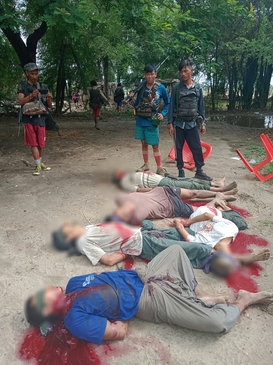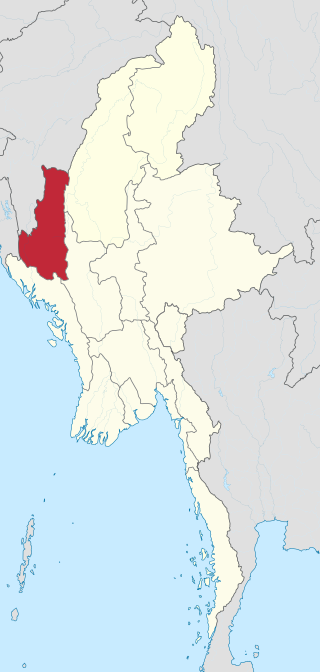
Insurgencies have been ongoing in Myanmar since 1948, the year the country, then known as Burma, gained independence from the United Kingdom. The conflict has largely been ethnic-based, with several ethnic armed groups fighting Myanmar's armed forces, the Tatmadaw, for self-determination. Despite numerous ceasefires and the creation of autonomous self-administered zones in 2008, many armed groups continue to call for independence, increased autonomy, or the federalisation of the country. The conflict is the world's longest ongoing civil war, having spanned more than seven decades.

The Rohingya conflict is an ongoing conflict in the northern part of Myanmar's Rakhine State, characterised by sectarian violence between the Rohingya Muslim and Rakhine Buddhist communities, a military crackdown on Rohingya civilians by Myanmar's security forces, and militant attacks by Rohingya insurgents in Buthidaung, Maungdaw, and Rathedaung Townships, which border Bangladesh.

The Arakan Army, officially the Arakha Army is an ethnic armed organisation based in Rakhine State (Arakan). Founded on 10 April 2009, the AA is the military wing of the United League of Arakan (ULA). It is currently led by Commander-in-Chief Major General Twan Mrat Naing and vice deputy commander-in-chief Brigadier General Nyo Twan Awng. The Arakan Army states that the objective of its armed revolution is to restore the sovereignty of the Arakan people. In a February 2024 interview, Twan Mrat Naing claimed that the AA had grown to at least 38,000 troops. Anthony Davis, an expert of military and security, rejected this claim and estimated that it has at least 15,000 troops in Chin State and Rakhine State, in addition to around 1500 in Kachin State and Shan State. In the early 2010s, the Arakan Army fought alongside the Kachin Independence Army (KIA) against the Tatmadaw in the Kachin conflict. Following the 2016 outbreak of conflict in Rakhine state, AA became more heavily involved in the Arakan region. In 2019, AA would launch attacks on state security forces and the Myanmar Army would respond heightening clashes. The AA reached a ceasefire in late 2020 after eroding the central government's control in northern Rakhine. The power vacuum would be filled by the AA over the next 18 months with state-building efforts, like their COVID-19 vaccine rollouts.

The Arakan Rohingya Salvation Army (ARSA), formerly known as Harakah al-Yaqin, is a Rohingya insurgent group active in northern Rakhine State, Myanmar. According to a December 2016 report by the International Crisis Group, it is led by Ataullah abu Ammar Jununi, a Rohingya man who was born in Karachi, Pakistan, and grew up in Mecca, Saudi Arabia. Other members of its leadership include a committee of Rohingya émigrés in Saudi Arabia.

The Rohingya genocide is a series of ongoing persecutions and killings of the Muslim Rohingya people by the military of Myanmar. The genocide has consisted of two phases to date: the first was a military crackdown that occurred from October 2016 to January 2017, and the second has been occurring since August 2017. The crisis forced over a million Rohingya to flee to other countries. Most fled to Bangladesh, resulting in the creation of the world's largest refugee camp, while others escaped to India, Thailand, Malaysia, and other parts of South and Southeast Asia, where they continue to face persecution. Many other countries consider these events ethnic cleansing.
Violent clashes have been ongoing in the northern part of Myanmar's Rakhine State since October 2016. Insurgent attacks by the Arakan Rohingya Salvation Army (ARSA) have led to sectarian violence perpetrated by Myanmar's military and the local Buddhist population against predominantly Muslim Rohingya civilians. The conflict has sparked international outcry and was described as an ethnic cleansing by the United Nations High Commissioner for Human Rights. In August 2017, the situation worsened and hundreds of thousands of refugees fled Myanmar into Bangladesh, with an estimated 500,000 refugees having arrived by 27 September 2017. In January 2019, Arakan Army insurgents raided border police posts in Buthidaung Township, joining the conflict and beginning their military campaign in northern Rakhine State against the Burmese military.
The Gu Dar Pyin massacre was a mass-killing of Rohingya people by the Myanmar Army and armed Rakhine locals that reportedly happened in the village of Gu Dar Pyin, in Rakhine State, Myanmar on 27 August 2017. According to eyewitness testimony and video evidence first reported by the Associated Press, victims of the massacre were buried in five mass graves by the Myanmar Army and burnt with acid. An official count given by the Burmese government put the death toll at ten, whilst Rohingya village elders recorded a list of 75 people who may have died in the massacre and locals estimated that up to 400 people were killed in the massacre.

The People's Defence Force is the armed wing of the National Unity Government in Myanmar. The armed wing was formed by the NUG from youths and pro-democracy activists on 5 May 2021 in response to the coup d'état that occurred on 1 February 2021 that put the military junta and their armed wing the Tatmadaw in power. The military junta designated it as a terrorist organisation on 8 May 2021. In October 2021, NUG's Ministry of Defence announced that it had formed a central committee to coordinate military operations across the country.

The Myanmar civil war, also called the Burmese Spring Revolution, Burmese civil war or People's Defensive War, is an ongoing civil war following Myanmar's long-running insurgencies, which escalated significantly in response to the 2021 military coup d'état and the subsequent violent crackdown on anti-coup protests. The exiled National Unity Government and major ethnic armed organisations repudiated the 2008 Constitution and called instead for a democratic federal state. Besides engaging this rebel alliance, the junta also contends with other anti-junta forces in areas under its control. Hannah Beech of The New York Times observed the insurgents are apportioned into hundreds of armed groups scattered across the country.
Events in the year 2022 in Myanmar.
The following is a timeline of major events during the Myanmar civil war (2021–present), following the 2021 military coup d'état and protests. It was also a renewed intensity in existing internal conflict in Myanmar.
This is the list of important events happened in Myanmar in 2023.
The Let Yet Kone massacre was a mass killing of civilians on 16 September 2022, at a monastic school in the village of Let Yet Kone, near Tabayin in Sagaing Region, in north-western Myanmar. During the massacre, Myanmar Army and Myanmar Air Force troops killed at least 13 civilians, including 8 children. The event became one of Myanmar's deadliest civilian massacres involving children in 2022, during which 165 children were killed by military forces.
The Tar Taing massacre was a mass killing of civilians by Burmese military forces between 1 and 2 March 2023, in the village of Tadaing, Sagaing Region, located 28 miles (45 km) west of Mandalay, Myanmar's 2nd largest city. During the massacre, Myanmar Army troops killed at least 17 civilians. The event has become one of Myanmar's deadliest civilian massacres in 2023. Just nine days after this massacre, military troops killed at least 28 additional individuals in the Pinlaung massacre.
The Pinlaung massacre was a mass killing of civilians by Burmese military forces on 11 March 2023, in the village of Namneng, Shan State. During the massacre, Myanmar Army troops killed at least 30 civilians, including 3 Buddhist monks. The massacre occurred 9 days after the Tar Taing massacre in Sagaing.

The Mon Taing Pin massacre was a mass killing of civilians by Burmese military forces on 11 May 2022, in the village of Mondaingbin, Sagaing Region, Myanmar. During the massacre, Myanmar Army troops executed at least 37 villagers. Sagaing Region later became the site of several additional mass killings perpetrated by the Burmese military, including the Letyetkon and Tadaing massacres.
On 11 April 2023, the Myanmar Air Force massacred at least 165 people in the village of Pazigyi, Kantbalu Township, which is located 92 miles (148 km) west of Mandalay, Myanmar's second largest city. The air force used fighter jets and helicopters to attack a large crowd of people gathering for the opening of a local office of an opposition movement. The Pazigyi attack was the junta's deadliest attack since seizing power in the 2021 coup d'état.

The Chin theater is one of the theaters of the Myanmar civil war (2021–present), with resistance forces fighting against the Tatmadaw military junta in Chin State, western Myanmar.

On November 13, 2023, the Arakan Army (AA), one of the dozens of ethnic resistance groups active in the civil war in Myanmar, launched a military offensive against Myanmar's military junta in Rakhine and southern Chin State. Fighting began concurrently with the launch of Operation 1027, which the Arakan Army, as a member of the Three Brotherhood Alliance, also participated in. The offensive broke an informal ceasefire between the Arakan Army and the junta that had been in place for a year. During the offensive, the Arakan Army would capture several towns in northern Rakhine including Mrauk U, the capital of Mrauk-U District and the historical capital of Arakan. They would then focus on attacking Sittwe, the state capital, and Ann, the headquarters of the junta's western command. International Institute for Strategic Studies reported AA’s sweeping gains "are already enough to enable self-rule over a large portion of the Rakhine homeland and to reshape the wider balance of power in Myanmar."








